Vidakovic B. Statistics for Bioengineering Sciences: With Matlab and WinBugs Support
Подождите немного. Документ загружается.

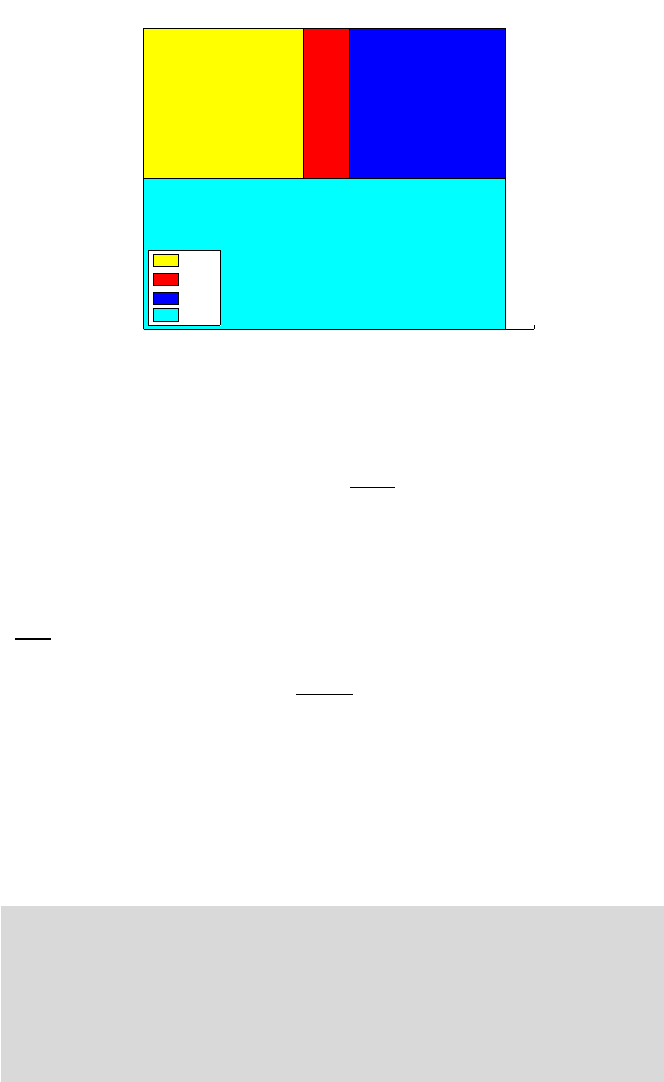
11.7 Power Analysis in ANOVA 439
0 500 1000 1500 2000 2500
0
0.2
0.4
0.6
0.8
1
1.2
1.4
1.6
1.8
2
Sums of Squares
SSA
SSB
A
SSE
SST
Fig. 11.6 The budget of sums of squares for the mouse-diet study.
hypothesis H
0
: α
1
=α
2
=···=α
k
=0. It quantifies the extent of deviation from
H
0
and usually is a function of the ratio
P
n
i
α
2
i
σ
2
.
Under H
0
, for a balanced design, the test statistic F has an F-distribution
with k
−1 and N −k = k(n −1) degrees of freedom, where k is the number of
treatments and n the number of subjects at each level.
However, if H
0
is not true, the test statistic has a noncentral F-distribution
with k
−1 and k(n −1) degrees of freedom and a noncentrality parameter λ =
n
P
i
α
2
i
σ
2
.
An alternative way to set the precision is via Cohen’s effect size, which
for ANOVA takes the form f
2
=
1/k
P
i
α
2
i
σ
2
. Note that Cohen’s effect size and
noncentrality parameter are connected via
λ = N f
2
= nk f
2
.
Since determining the sample size is a prospective task, information about
σ
2
and α
i
may not be available. In the context of ANOVA Cohen (1988) recom-
mends effect sizes of f
2
= 0.1
2
as small, f
2
= 0.25
2
as medium, and f
2
= 0.4
2
as large.
The power in ANOVA is, by definition,
1
−β =P(F
nc
(k −1, N −k,λ) >F
−1
(1 −α, k −1, N −k)), (11.5)
where F
nc
(k −1, N − k,λ) is a random variable with a noncentral F-
distribution with k
−1 and N −k degrees of freedom and noncentrality

440 11 ANOVA and Elements of Experimental Design
parameter λ. The quantity F
−1
(1 −α, k −1, N −k) is the 1 −α percentile
(a cut point for which the upper tail has a probability
α) of a standard
F-distribution with k
−1 and N −k degrees of freedom.
The interplay among the power, sample size, and effect size is illustrated
by the following example.
Example 11.8. Suppose k
=4 treatment means are to be compared at a signif-
icance level of
α =0.05. The experimenter is to decide how many replicates n
to run at each level, so that the null hypothesis is rejected with a probability
of at least 0.9 if f
2
=0.0625 or if
P
i
α
2
i
is equal to σ
2
/4.
For n
=60, i.e., N =240, the power is calculated in a one-line command:
1-ncfcdf(finv(1-0.05, 4-1, 4
*
(60-1)), 4-1, 4
*
(60-1), 15) %0.9122
Here we used λ = nk f
2
=60 ×4 ×0.0625 =15.
One can now try different values of n (group sample sizes) to achieve
the desired power; this change affects only two arguments in Eq. (11.5):
k(n
−1) and λ = nk f
2
. Alternatively, one can use MATLAB’s built in function
fzero(fun,x0) which tries to find a zero of fun near some initial value x0.
k=4; alpha = 0.05; f2 = 0.0625;
f = @(n) 1-ncfcdf( finv(1-alpha, k-1,k
*
n-k),k-1,k
*
n-k, n
*
k
*
f2 ) - 0.90;
ssize = fzero(f, 100) %57.6731
%Sample size of n=58 (per treatment) ensures the power of 90% for
%the effect size f^2=0.0625.
Thus, sample size of n = 58 will ensure the power of 90% for the specified
effect size. The function
fzero is quite robust with respect to specification of
the initial value; in this case the initial value was n
=100.
If we wanted to plot the power for different sample sizes (Fig. 11.7), the
following simple MATLAB script would do it. The inputs are the k number
of treatments and the significance level
α. The specific alternative H
1
is such
that
P
i
α
2
i
=σ
2
/4, so that λ = n/4.
k=4; %number of treatments
alpha = 0.05; %significance level
y=[]; %set values of power for n
for n=2:100
y =[y 1-ncfcdf(finv(1-alpha, k-1, k
*
(n-1)), ...
k-1, k
*
(n-1), n/4)];
end
plot(2:100, y,’b-’,’linewidth’,3)
xlabel(’Group sample size n’); ylabel(’Power’)
In the above analysis, the total sample size is N = k ×n =240.
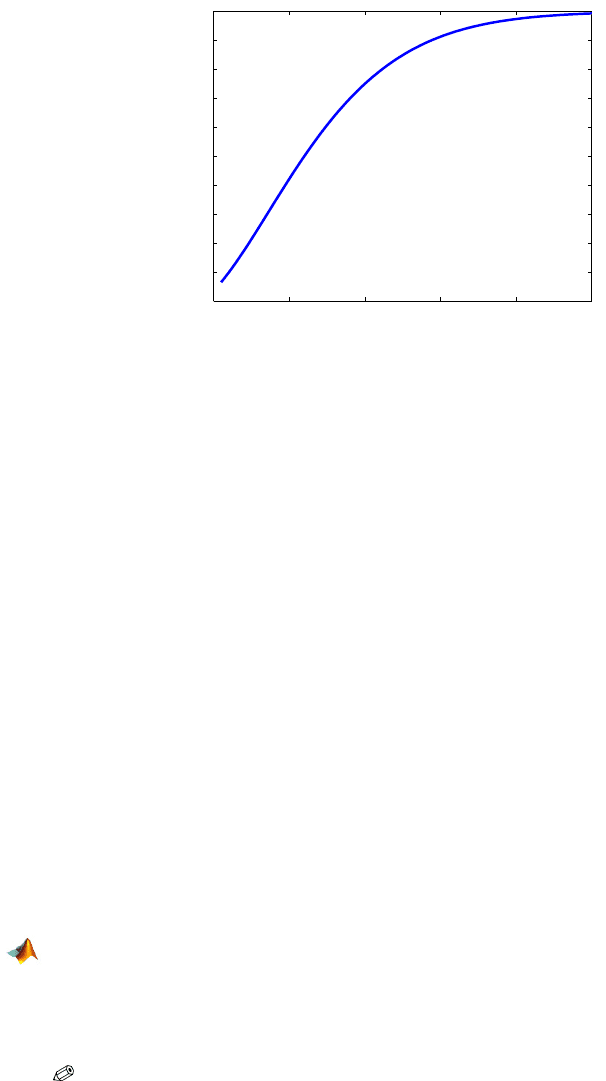
11.7 Power Analysis in ANOVA 441
0 20 40 60 80 100
0
0.1
0.2
0.3
0.4
0.5
0.6
0.7
0.8
0.9
1
Group sample size n
Power
Fig. 11.7 Power for n ≤100 (size per group) in a fixed-effect ANOVA with k =4 treatments
and
α =0.05. The alternative H
1
is defined as
P
i
α
2
i
=σ
2
/4 so that the parameter of noncen-
trality
λ is equal to n/4.
Sample Size for Multifactor ANOVA. A power analysis for multifactor
ANOVA is usually done by selecting the most important factor and evaluating
the power for that factor. Operationally, this is the same as the previously
discussed power analysis for one-way ANOVA, but with modified error degrees
of freedom to account for the presence of other factors.
Example 11.9. Assume two-factor, fixed-effect ANOVA. The test for factor A at
a
=4 levels is to be evaluated for its power. Factor B is present and has b =3
levels. Assume a balanced design with 4
×3 cells, with n = 20 subjects in each
cell. The total number of subjects in the experiment is N
=3 ×4 ×20 =240.
For
α = 0.05, a medium effect size f
2
= 0.0625, and λ = N f
2
= 20 ×4 ×3 ×
0.0625 =15, the power is 0.9121.
1-ncfcdf(finv(1-0.05, 4-1, 4
*
3
*
(20-1)), 4-1, 4
*
3
*
(20-1), 15) %0.9121
Alternatively, if the cell sample size n is required for a specified power we
can use function
fzero.
a=4; b=3; alpha = 0.05; f2=0.0625;
f = @(n) 1-ncfcdf( finv(1-alpha, a-1,a
*
b
*
(n-1)), ...
a-1, a
*
b
*
(n-1), a
*
b
*
n
*
f2) - 0.90;
ssize = fzero(f, 100) %19.2363
%sample size of 20 (by rounding 19.2363 up) ensures 90% power
%given the effect size and alpha

442 11 ANOVA and Elements of Experimental Design
Sample Size for Repeated Measures Design. In a repeated measures
design, each of the k treatments is applied to every subject. Thus, the total
sample size is equal to a treatment sample size, N
= n. Suppose that ρ is the
correlation between scores for any two levels of the factor and it is assumed
constant. Then the power is calculated by Eq. (11.5), where the noncentrality
parameter is modified as
λ =
n
P
i
α
2
i
(1 −ρ)σ
2
=
nk f
2
1 −ρ
.
Example 11.10. Suppose that n
=25 subjects go through k =3 treatments and
that a correlation between the treatments is
ρ = 0.6. This correlation comes
from the experimental design; the measures are repeated on the same sub-
jects. Then for the medium effect size (f
= 0.25 or f
2
= 0.0625) the achieved
power is 0.8526.
n=25; k=3; alpha=0.05; rho=0.6;
f = 0.25; %medium effect size f^2=0.0625
lambda = n
*
k
*
f^2/(1-rho) %11.7188
power = 1-ncfcdf( finv(1-alpha, k-1, (n-1)
*
(k-1)),...
k-1, (n-1)
*
(k-1), lambda) %0.8526
If the power is specified at 85% level, then the number of subjects is ob-
tained as
k=3; alpha=0.05; rho=0.6; f=0.25;
pf = @(n) 1-ncfcdf( finv(1-alpha, k-1, (n-1)
*
(k-1)),...
k-1, (n-1)
*
(k-1), n
*
k
*
f^2/(1-rho) ) - 0.85;
ssize = fzero(pf, 100) %24.8342 (n=25 after rounding)
Often the sphericity condition is not met. This happens in longitudinal
studies (repeated measures taken over time) where the correlation between
measurements on days 1 and 2 may differ from the correlation between days
1 and 4, for example. In such a case, average correlation
ρ is elicited and used;
however, all degrees of freedom in central and noncentral F, as well as
λ, are
multiplied by sphericity parameter
².
Example 11.11. Suppose, as in Example 11.10, that n
=25 subjects go through
k
= 3 treatments, and that an average correlation between the treatments is
ρ = 0.6. If the sphericity is violated and parameter ² is estimated as ² = 0.7,
the power of 85.26% from Example 11.10 drops to 74.64%.
n=25; k=3; alpha=0.05; barrho=0.6; eps=0.7;
f = 0.25;

11.8 Functional ANOVA* 443
lambda = n
*
k
*
f^2/(1-barrho) %11.7188
power = 1-ncfcdf( finv(1-alpha, eps
*
(k-1), eps
*
(n-1)
*
(k-1)),...
eps
*
(k-1), eps
*
(n-1)
*
(k-1), eps
*
lambda) %0.7464
If the power is to remain at 85% level, then the number of subjects should
increase from 25 to 32.
k=3; alpha=0.05; barrho=0.6; eps=0.7; f = 0.25;
pf = @(n) 1-ncfcdf( finv(1-alpha, eps
*
(k-1), eps
*
(n-1)
*
(k-1)),...
eps
*
(k-1), eps
*
(n-1)
*
(k-1), eps
*
n
*
k
*
f^2/(1-barrho) ) - 0.85;
ssize = fzero(pf, 100) %31.8147
11.8 Functional ANOVA*
Functional linear models have become popular recently since many responses
are functional in nature. For example, in an experiment in neuroscience, ob-
servations could be functional responses, and rather than applying the experi-
mental design on some summary of these functions, one could use the densely
sampled functions as data.
We provide a definition for the one-way case, which is a “functionalized”
version of standard one-way ANOVA.
Suppose that for any fixed t
∈ T ⊂ R, the observations y are modeled by a
fixed-effect ANOVA model:
y
i j
(t) =µ(t) +α
i
(t) +²
i j
(t), i =1,..., k, j =1,... , n
i
;
k
X
i=1
n
i
= N, (11.6)
where
²
i j
(t) are independent N (0,σ
2
) errors. When i and j are fixed, we as-
sume that functions
µ(t) and α
i
(t) are square-integrable functions. To ensure
the identifiability of treatment functions
α
i
, one typically imposes
(
∀t)
X
i
α
i
(t) =0. (11.7)
In real life the measurements y are often taken at equidistant times t
m
.
The standard least square estimators for
µ(t) and α
i
(t)
ˆ
µ(t) = y(t) =
1
n
X
i, j
y
i j
(t), (11.8)
ˆ
α
i
(t) = y
i
(t) − y(t), (11.9)
where
y
i
(t) =
1
n
i
P
j
y
i j
(t), are obtained by minimizing the discrete version of
LMSSE [for example, Ramsay and Silverman (1997) p. 141],
LMSSE
=
X
t
X
i, j
[y
i j
(t) −(µ(t)+α
i
(t))]
2
, (11.10)

444 11 ANOVA and Elements of Experimental Design
subject to the constraint (∀t)
P
i
n
i
α
i
(t) =0.
The fundamental ANOVA identity becomes a functional identity,
SST(t)
=SSTr(t) +SSE(t), (11.11)
with SST(t)
=
P
i,l
[y
il
(t) − y(t)]
2
, SSTr(t) =
P
i
n
i
[y
i
(t) − y(t)]
2
, and SSE(t) =
P
i,l
[y
il
(t) − y
i
(t)]
2
.
For each t, the function
F(t)
=
SSTr(t)/(k −1)
SSE(t)/(N −k)
(11.12)
is distributed as noncentral F
k−1,N−k
µ
P
i
n
i
α
2
i
(t)
σ
2
¶
. Estimation of µ(t) and α
j
(t)
is straightforward, and estimators are given in Eqs. (11.8).
The testing of hypotheses involving functional components of the stan-
dard ANOVA method is hindered by dependence and dimensionality problems.
Testing requires dimension reduction and this material is beyond the scope of
this book. The interested reader can consult Ramsay and Silverman (1997)
and Fan and Lin (1998).
Example 11.12. FANOVA in Tumor Physiology. Experiments carried out
in vitro with tumor cell lines have demonstrated that tumor cells respond to
radiation and anticancer drugs differently, depending on the environment. In
particular, available oxygen is important. Efforts to increase the level of oxy-
gen within tumor cells have included laboratory rats with implanted tumors
breathing pure oxygen. Unfortunately, animals breathing pure oxygen may
experience large drops in blood pressure, enough to make this intervention
too risky for clinical use.
Mark Dewhirst, Department of Radiation Oncology at Duke University,
sought to evaluate carbogen (95% pure oxygen and 5% carbon dioxide) as a
breathing mixture that might improve tumor oxygenation without causing
a drop in blood pressure. The protocol called for making measurements on
each animal over 20 minutes of breathing room air, followed by 40 minutes
of carbogen breathing. The experimenters took serial measurements of oxy-
gen partial pressure (PO
2
), tumor blood flow (LDF), mean arterial pressure
(MAP), and heart rate. Microelectrodes, inserted into the tumors (one per ani-
mal), measured PO
2
at a particular location within the tumor throughout the
study period. Two laser Doppler probes, inserted into each tumor, provided
measurements of blood flow. An arterial line into the right femoral artery al-
lowed measurement of MAP. Each animal wore a face mask for administration
of breathing gases (room air or carbogen). [See Lanzen et al. (1998) for more
information about these experiments.]
Nine rats had tumors transplanted within the quadriceps muscle (which
we will denote by TM). For comparison, the studies also included eight rats
with tumors transplanted subcutaneously (TS) and six rats without tumors
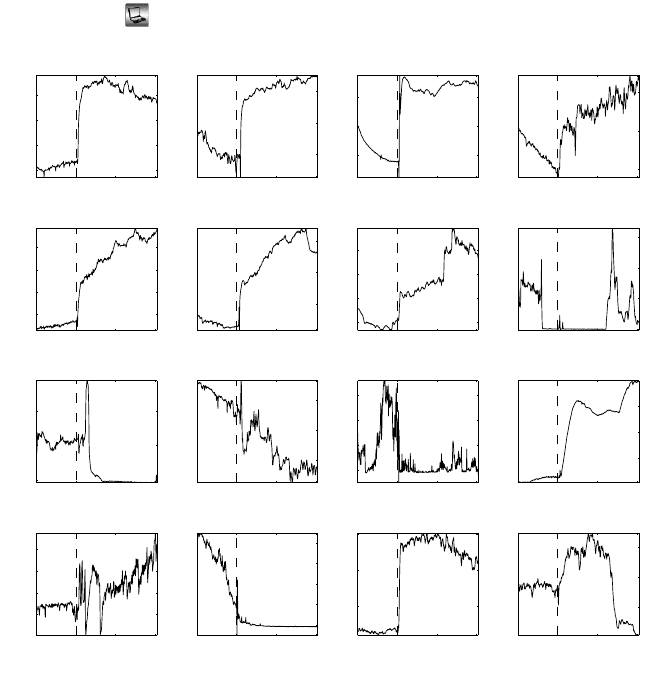
11.8 Functional ANOVA* 445
(N) in which measurements were made in the quadriceps muscle. The data
are provided in
oxigen.dat.
20 40 60
20
30
40
50
t (min)
Treatment 1
20 40 60
10
15
20
t (min)
Treatment 1
20 40 60
20
30
40
t (min)
Treatment 1
20 40 60
10
15
20
t (min)
Treatment 1
20 40 60
20
30
40
50
t (min)
Treatment 1
20 40 60
20
40
60
t (min)
Treatment 1
20 40 60
20
30
40
50
t (min)
Treatment 2
20 40 60
0
5
10
15
t (min)
Treatment 2
20 40 60
0
10
20
t (min)
Treatment 2
20 40 60
5
10
15
t (min)
Treatment 2
20 40 60
0
5
10
15
t (min)
Treatment 2
20 40 60
20
40
60
80
t (min)
Treatment 3
20 40 60
10
20
30
40
t (min)
Treatment 3
20 40 60
0
5
10
15
20
t (min)
Treatment 3
20 40 60
40
60
80
t (min)
Treatment 3
20 40 60
10
20
30
t (min)
Treatment 3
Fig. 11.8 PO
2
measurements. Notice that despite a variety of functional responses and a
lack of a simple parametric model, at time t
∗
=20
0
the pattern generally changes.
Figure 11.8 show some of the data (PO
2
). The plots show several features,
including an obvious rise in PO
2
at the 20-minute mark among some of the
animals. No physiologic model exists that would characterize the shapes of
these profiles mathematically. The primary study question concerned evaluat-
ing the effect of carbogen breathing on PO
2
. The analysis was complicated by
the knowledge that there may be acute changes in PO
2
after carbogen breath-
ing starts. The primary question of interest is whether the tumor tissue be-
haves differently than normal muscle tissue or whether a tumor implanted
subcutaneously responds to carbogen breathing differently than tumor tissue
implanted in muscle tissue in the presence of acute jumps in PO
2
.
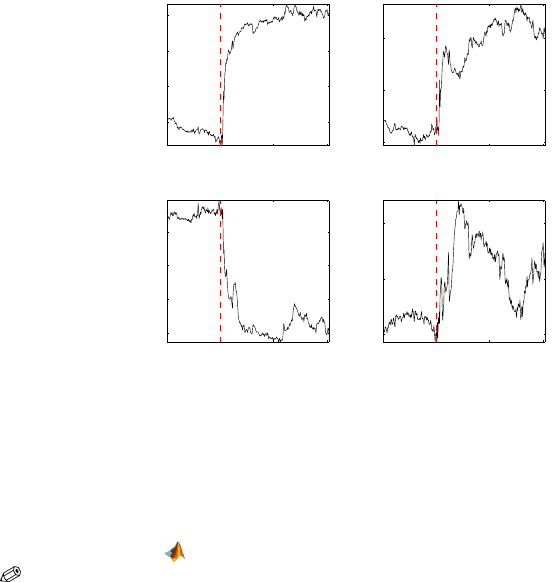
446 11 ANOVA and Elements of Experimental Design
The analyses concern inference on changes in some physiologic measure-
ments after an intervention. The problem for the data analysis is how best to
define “change” to allow for the inference desired by the investigators.
From a statistical modeling point of view, the main issues concern building
a flexible model for the multivariate time series y
i j
of responses and providing
for formal inference on the occurrence of change at time t
∗
and the “equality”
of the PO
2
profiles. From the figures it is clear that the main challenge arises
from the highly irregular behavior of responses. Neither physiologic consid-
erations nor any exploratory data analysis motivates any parsimonious para-
metric form. Different individuals seem to exhibit widely varying response
patterns. Still, it is clear from inspection of the data that for some response
series a definite change takes place at time t
∗
.
20 40 60
15
20
25
30
t (min)
µ(t)
20 40 60
0
5
10
t (min)
α
1
(t)
20 40 60
−20
−15
−10
−5
t (min)
α
2
(t)
20 40 60
0
5
10
t (min)
α
3
(t)
Fig. 11.9 Functional ANOVA estimators.
Figure 11.9 shows the estimators of components in functional ANOVA. One
can imagine from the figure that adding
µ(t) and α
2
(t) will lead to a relatively
horizontal expected profile for group i, each fitted curve canceling the other to
some extent. Files
micePO2.m and fanova.m support this example.
11.9 Analysis of Means (ANOM)*
Some statistical applications, notably in the area of quality improvement, in-
volve a comparison of treatment means to determine which are significantly

11.9 Analysis of Means (ANOM)* 447
different from their overall average. For example, a biomedical engineer might
run an experiment to investigate which of six concentrations of an agent pro-
duces different output, in the sense that the average measurement for each
concentration differs from the overall average.
Questions of this type are answered by the analysis of means (ANOM),
which is a method for making multiple comparisons that is sometimes referred
to as a “multiple comparison with the weighted mean”. The ANOM answers
different question than the ANOVA; however, it is related to ANOVA via mul-
tiple tests involving contrasts (Halperin et al., 1955; Ott, 1967)
The ANOM procedure consists of multiple testing of k hypotheses H
0i
: α
i
=
0, i =1, ..., k versus the two sided alternative. Since the testing is simultane-
ous, the Bonferroni adjustment to the type I error is used. Here
α
i
are, as in
ANOVA, k population treatment effects
µ
i
−µ, i =1,..., k which are estimated
as
ˆ
α
i
= y
i
− y,
in the usual ANOVA notation. Population effect
α
i
can be represented via the
treatment means as
α
i
= µ
i
−µ =µ
i
−
µ
1
+···+µ
k
k
= −
1
k
µ
1
−···−
1
k
µ
i−1
+
µ
1 −
1
k
¶
µ
i
−···−
1
k
µ
k
.
Since the constants c
1
=−1/k, ... , c
i
=1 −1/k, . .., c
k
=−1/k sum up to 0,
ˆ
α
i
is
an empirical contrast,
ˆ
α
i
= y
i
−
y
1
+···+ y
k
k
= −
1
k
y
1
−···−
1
k
y
i−1
+
µ
1 −
1
k
¶
y
i
−···−
1
k
y
k
,
with standard deviation (as in p. 417),
s
ˆ
α
i
= s
v
u
u
t
k
X
j=1
c
2
j
n
j
= s
v
u
u
t
1
n
i
µ
1 −
1
k
¶
2
+
1
k
2
X
j6=i
1
n
j
.
Here n
i
are treatment sample sizes, N =
P
k
i
=1
n
i
is the total sample size, and
s
=
p
MSE.
All effects
ˆ
α
i
falling outside the interval
[
−s
ˆ
α
i
×t
N−k,1−α/(2k)
, s
ˆ
α
i
×t
N−k,1−α/(2k)
],
or equivalently, all treatment means
y
i
falling outside of the interval
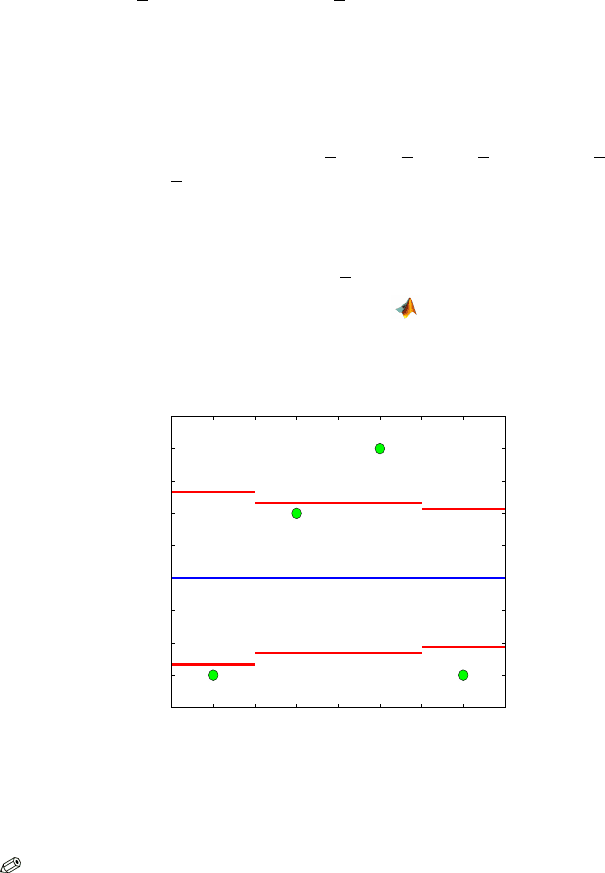
448 11 ANOVA and Elements of Experimental Design
[y −s
ˆ
α
i
×t
N−k,1−α/(2k)
, y +s
ˆ
α
i
×t
N−k,1−α/(2k)
],
correspond to rejection of H
0i
: α
i
= µ
i
−µ = 0. The Bonferroni correction 1 −
α/(2k) in the t-quantile t
N−k,1−α/(2k)
controls the significance of the procedure
at level
α (p. 342).
Example 11.13. We revisit Example 11.1 (Coagulation Times) and perform
an ANOM analysis. In this example
y
1
= 61, y
2
= 66, y
3
= 68, and y
4
= 61.
The grand mean is
y = 64. Standard deviations for
ˆ
α are s
ˆ
α
1
= 0.9736, s
ˆ
α
2
=
0.8453, s
ˆ
α
3
= 0.8453, and s
ˆ
α
4
= 0.7733, while the t-quantile corresponding to
α = 0.05 is t
1−0.05/8,20
= 2.7444. This leads to ANOM bounds, [61.328,66.672],
[61.680,66.320], [61.680,66.320], and [61.878,66.122].
Only the second treatment mean
y
2
= 66 falls in its ANOM interval
[61.680, 66.320], see Fig. 11.10 (generated by
anomct.m). Consequently, the
second population mean
µ
2
is not significantly different from the grand mean
µ.
0.5 1 1.5 2 2.5 3 3.5 4 4.5
60
61
62
63
64
65
66
67
68
69
Fig. 11.10 ANOM analysis in example Coagulation Times. Blue line is the overall mean,
red lines are the ANOM interval bounds, while green dots are the treatment means. Note
that only the second treatment mean falls in its interval.
11.10 The Capability of a Measurement System (Gauge
R&R ANOVA)*
The gauge R&R methodology is concerned with the capability of measur-
ing systems. Over time gauge R&R methods have evolved, and now two ap-
